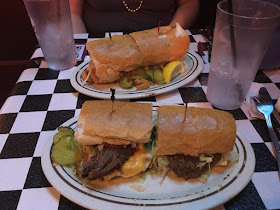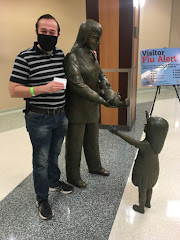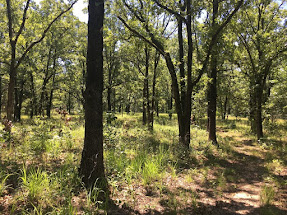I recently traveled to New Orleans, LA, to present my research on William Mayo and East Texas Normal College at the 2021 Southwestern Social Association Meeting. As always, I enjoyed meeting many bright scholars and presenting my research to an audience. The conference was held at one of the city's lavish 4-star hotels, The Monteleone. I am grateful for the warm hospitality and professional advice I received from my session chair, Dr. Eddie Weller, a history professor and director of the Honors Program at San Jacinto College in Houston. I will be writing about my New Orleans experiences in the next blog entries. Below, is a transcript of the paper I presented at this fantastic conference. It was titled King of Lions: William Leonidas Mayo and East Texas Normal College.
“Ceaseless Industry,
Fearless Investigation, Unfettered Thought, and Unselfish Service to Others.”
William
Mayo’s firm declaration, comprised of 11 words, have influenced administrative
policies at Texas A&M-Commerce over the course of its 132-year history. His
teachings sparked a progressive overhaul in state education at the end of the
nineteenth century and his spirit continues to inspire thousands of graduates
to walk the stage as scholars, specialized professionals, and community
leaders. Today, I will be analyzing Mayo’s strong leadership approach and
unwavering efforts to provide a quality education to poorer folks in rural East
Texas. |
| William Mayo had an ambitious plan for his future... c. 1895. |
A
proud native of Kentucky, William Leonidas Mayo quickly learned to become an
independent, industrious teenager—traits that he would later educate his
students on. At age 15 in 1876, young William, the sharpest student in his
class, was asked to take over classroom duties after his teacher was elected
sheriff. Afterwards, the ambitious secondary school graduate once again found
himself in front of the classroom as a teacher’s assistant at Central Normal
College after Professor Franklin P. Adams (who was also the president) was
galvanized at William’s passion for teaching. Prior to his move to Texas in the
late 1880s, Mayo was a beloved principal at Cedar Bluff Academy in Virginia,
where he established a robust curriculum that used “contemporary,
student-centered, civically-engaged pedagogy.” Craving a new adventure, Mayo
traveled to the Lone Star State in 1886, where he visited relatives and sought
a school superintendent position in Cooper, a sparsely-populated town in the
backwoods of Northeast Texas. Prior to his interview, Mayo created an unusual
proposal for the Cooper Joint Stock School District: he offered to turn the
district’s only school into a “first-class, private college.”
Mayo
reassured the school district that his college would employ a rigorous
curriculum where students would be required to have an active and constructive
participation record in all classes. “If a father wants to make a son a
carpenter,” Mayo wrote to a teacher in Cooper, “he does not sit him down and
lecture to him about carpentering; instead, he gives him tools and puts him to
work on a definite plan.” Mayo’s “learning-by-doing” style of instruction
convinced the administrators to support the college proposal. And the rest is
history… A T-shaped, two-story wooden structure was built near the town
square to house classrooms, offices, and an apartment for Mayo. East Texas
Normal College opened its doors to 16 pupils on September 2, 1889. Unlike many
other colleges at the end of the nineteenth century, Mayo’s institution
permitted women to enroll in the same classes as men. Despite receiving some disapproving
glances from Presidents Thornton Rogers Sampson of Austin College and Henry T.
Bridges of Henry College, Mayo ignored the skeptics and became a visionary
pioneer who initiated radical changes in Texas education without regard for sex
or class. He once wrote that “every person, whatever his [or her] vocation in
life ought to possess this amount of knowledge, in order that he [or she] may
perform intelligently his [or her] part as an active American citizen.”
 |
| Mayo taught thousands of students at ET, including this graduating class in 1903. Sam Rayburn is standing in the back row, second from the right. He was hiding behind his classmates since he was embarrassed by his unclean suit. |
In
an attempt to beef up enrollment in the early 1890s, Professor Mayo
crisscrossed the state, publicizing his innovative school while decrying the existing
“elitist” liberal arts colleges and criticizing the traditional lecture system.
“The pupil sits at the front of the instructor and accepts, without thought or
question, everything that is said…” he openly declared. “He learns to follow,
not to lead; to accept the opinions of others, not to think for himself; to
read the results of their investigations, not to make these investigations for
himself. Such is not an education.” On the flip side, Mayo magnified his
curriculum, which combined elements of rugged individualism and progressive
politics. As the student body swelled, the number of faculty also grew. Mayo hired
instructors who facilitated student learning and encouraged students to express
their opinions on a variety of texts. The professor frequently reiterated to
his faculty that “the classroom is the place for the pupil to learn how to use
his own powers, and if the teacher usurps this, he is the meanest of tyrants—a
tyrant of human souls.” At the college, Miss Edna Tullis taught foreign
languages; B.L. Phipps was hired as the sciences expert; and W.E. Boyd taught
mathematics.
A
public hanging of a felon and a devastating fire—which destroyed the college
building and student records—in July 1894 convinced Mayo to relocate his school
to Commerce, about 15 miles southwest. The move proved to be lucrative. Since
Commerce had a railroad depot (which Cooper had not had), students who lived
miles away were now able to travel via the railroad and attend Mayo’s college.
At eight in the morning on September 3, 1894, East Texas Normal College
reopened. 35 students attended the first class, which was held on the second
floor of the downtown bank. A generous donation from the city (10 acres and
$10,000 in cash) allowed the college to permanently plant their roots on the
outskirts of the downtown square and move into a six-classroom structure later
known as “College Hall.” Mayo continued to persuade prospective students that
his challenging curriculum provoked a student to question the world’s ideas and
“stir him [or her] to discover the meaning of ideas.” Classes at the college
included logic, psychology, rhetoric, history, ancient and modern languages,
mathematics, biology, and economics. Students had the option to pursue a three-year
bachelor's degree in either literature, pedagogy, or classics. Positive word on
the college spread, and enrollment soared to 713 students in 1903.
 |
| Sam Rayburn and then-Senate Majority Leader LBJ, 1958. Rayburn received an honorary degree from his alma mater in 1943. |
Sam
Rayburn, a native of Ladonia, received $25 from his father to board a train
headed to Commerce in fall 1900. Rayburn was a history buff, and enjoyed
reading biographies of U.S. presidents and partaking in class debates. Like
many of his classmates, he found Mayo’s classes demanding, later writing, “we
students had to keep on our toes in Professor Mayo’s classes.” Mr. Sam’s global
citizenship and public speaking skills flourished at East Texas Normal College:
he played Brutus in a production of Julius Caesar, and joined the
college’s literature societies. To help cover the costs of tuition and books,
Rayburn rang the school bell and swept the floors in local schools—he earned $3
a month with these jobs. Rayburn graduated in July 1903 and following a short
stint as a teacher, he used the extraordinary skillset he had acquired from
Mayo’s college to win the people’s hearts during the 1912 congressional
election. Mr. Sam was a distinguished Washington D.C. policymaker for 50 years,
including a 17-year tenure as the Speaker of the House—a record that remains unsurpassed
today. Despite his lengthy service in the nation’s capital, Sam Rayburn never broke
ties with his alma mater nor forgot his humble beginnings in East Texas. Prior
to his death in 1961, he wrote: “If it hadn’t been for Mayo’s college, his
credit system and his inspiration, I don’t know where I’d be today. Professor
Mayo instilled in me the importance of a man’s having an objective in life, of
the need to have a program and to bend every energy to it.”
Mayo
became a father figure to his students at the college, gently prodding the
younglings in the right direction and never displaying an overbearing persona
when he didn’t need to. There were moments when the professor demonstrated his
authority by “boxing unruly students on their ears, [and] sending others home
for infractions…” Since his intentions were appropriate when he disciplined,
the students adhered to the policies and respected Mayo’s leadership. The
family atmosphere that was installed on campus thrived during the chapel
services each morning. Chapel had some religious overtones, but the meetings
focused primarily on character building and positive messages that the rural student
body could excel in school and make contributions to the world in which they
lived. The faculty also enjoyed hearing Mayo speak of his support for students
and staff. James Bledsoe, a professor of mathematics, once penned, “many a time
have I filed out of the Chapel Hall, after listening to one of these masterful
addresses of Mayo, boiling over with enthusiasm and determination…with a
feeling that there was absolutely nothing impossible for me to attempt and
accomplish…”
 |
| The South and North Dormitories at ETNC, 1903. Mayo and his family had an apartment on campus. |
Not
only was he a revered educator, but Mayo was also an around-the-clock mentor,
electing to live on campus and help to resolve students’ concerns outside of
the classroom. He was assisted by his wife, Henrietta (nicknamed “Etta”), a
music instructor at the college, after the pair married in June 1891. Etta
supported male students during animated debates as sponsor of the Lightfoot
Society, and encouraged female students to raise their voices against
patriarchal forces during the Suffrage Movement. William and Etta Mayo had 8
children. Their eldest daughter, Gladys, was born in Mayo’s campus
apartment in Cooper, and inherited her mother’s music talents and became a
professor at the Julliard School of Performing Arts in New York. Marion was born in the first dormitory in Commerce after the campus had
relocated. An athletic junkie, Marion secretly established the college’s
football team in 1915 after his father labeled it “a violent sport.” Professor
Mayo soon discovered his son’s hobby and eliminated football play until he
reinstated it a year later (after much persuasion). Mayo’s youngest son, 10-year-old
Stephen, was known to partake in drills with army cadets during World War I.
Several
Northeast Texas schools and colleges, including Henry College, closed their
doors at the start of the twentieth century due to financial problems. Although
faced with similar stumbling blocks, Mayo saved his pennies on every
construction project by bypassing expensive building companies and “going
direct[ly] to the sawmills and brick kilns of East Texas to purchase these
materials,” a construction manager later recalled. He stretched his existing
buildings to capacity, often holding over-flow classes in the dormitories when
the student body swelled in size. Following fires in 1907 and 1911, Mayo
tirelessly traveled the state, asking collectors to generously donate books to
the college’s library for pennies. He was successful; book-lovers gave 13,000
volumes, including the complete works of Thomas Jefferson.
 |
| Marion, the Mayo's fourth child, secretly established the college's first football team. |
Moreover,
as a self-described workaholic, Mayo would often be found washing dirty dishes
in the kitchens or swinging a hammer on an uncompleted building frame or
plowing the grounds at the crack of dawn or prior to sunset. “By applying my
own labor to our work,” he once wrote, “I can save over $200 that would go to
carpenters.” The professor also encouraged his students to use the existing
tools and budget, and never waste time nor take the easy road to success. “DO
NOT IDLE. STUDY WELL. SEIZE TIME BY THE FORELOCK,” Mayo once wrote on the
chalkboard in bold letters at the start of classics class. Mayo’s industrious
work ethic and money-saving schemes drastically lowered the tuition costs—the
institution was affordable for all, and would be known as the “poorer man’s
college” for many years.
The
physical labor in building the campus exhausted Mayo, and the professor rapidly
aged and became ill. At the beginning of 1917, the faculty approached Mayo and
suggested that he relinquish his claim to the private college and place it
under the authority of the state’s Board of Regents of the Normal Schools. Mayo
reluctantly agreed. Texas Senator Richard E. Westbrook of Wolfe City—who was an
alumnus of the college—took the matter in his own hands and drafted bill S.B.
231. On February 17, the state Senate passed the bill, and the state House
approved the motion (79-41) on March 14 at 2:55PM, ensuring that Mayo’s little
college would endure for generations to come. Westbrook sent a jubilant
telegram to Mayo shortly afterwards: “There is glory enough in this history for
us all.” Unfortunately, the telegram arrived 22 minutes too late. Professor
Mayo died suddenly that afternoon at 3:30PM after collapsing from heart
failure. He was only 55 years old. A life that was suddenly taken away, yet had
more potential.
 |
| A small flower memorial site near Old Main was created by students when Mayo died, 1917. |
Students
and faculty at the East Texas State Normal College mourned the loss of their
professor, mentor, and friend. Classes were suspended on March 15, and the
campus buildings were draped in black flags. Over the course of three decades,
an outspoken and creative educator transformed the educational landscape of
Texas, establishing a progressive, inclusive institution that gave agency,
opportunity and resources to those in the bottom half of the socioeconomic
scale. The maverick teacher had changed the lives of many (taught over 30,000
students), emphasizing the absolute necessity and importance of wholesome
discipline and character building in a sound system of education. By 1917, the
college had trained more public school teachers than any other academic
institution in Texas, and the school would continue to educate, inspire, and
empower many students as time rolled on. Today, Texas A&M
University-Commerce, the third-largest school in the Texas A&M System,
offers a competitive, enriching, and dynamic education to thousands of domestic
and international learners, all of whom are eager to arrive on campus and grow
as scholars, think like leaders, and learn to be Lions.
** One final thing to
conclude, an unusual piece of history: Prior to his death, Professor Mayo
pointed to a black locust thicket outside his office window and declared that he
wanted to be buried there. After her husband passed away, Etta was adamant that
her husband’s grave on campus would never be moved by future presidents. So,
she hired William J. McKittrick, Commerce’s concrete paver, to pour concrete
over Mayo’s coffin before the grave was filled with dirt. Mr. McKittrick’s
droning mixing machine could be heard during Mayo’s funeral; a disturbing sound
in a gloomy moment. When the funeral was over and the crowd dispersed, Mr.
McKittrick walked over and yelled down into the open grave: “Mr. Mayo, if you
are ever going to come out, come out now. I am going to cover you with
concrete.” There was silence, and the grave was filled. And William Mayo
continues to rest in his grave on campus, one of the few college presidents to do
so. I’ve had to do a couple of campus tours with new staff members, and it
always makes me laugh when people either scrunch up their face or widen their
eyes and comment, “A dead man is buried here?!”
 |
| Holding my presentation poster that was composed of archival photographs of Mayo and ETNC. |



























































